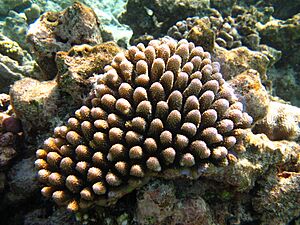Acropora globiceps facts for kids
Quick facts for kids Acropora globiceps |
|
|---|---|
 |
|
| Conservation status | |
| Scientific classification | |
| Synonyms | |
|
Acropora globiceps is a type of coral that lives in the ocean. It's found in the central and western Pacific Ocean and also in the central Indo-Pacific region. You can spot it in famous places like the Great Barrier Reef in Australia, the Philippines, and even the Andaman Islands. This coral usually grows on the sides of coral reefs or on flat reef areas, in shallow, warm waters. It's often found about 8 meters (about 26 feet) deep. A scientist named James Dwight Dana first described this coral way back in 1846.
What Does This Coral Look Like?
Acropora globiceps corals grow in small groups that look a bit like fingers or branches. These branches are usually quite close together. The tiny cups where the coral polyps live, called corallites, can look different depending on where the coral grows.
For example, corallites on reef slopes might be shaped like tubes. Those on flat reef areas might be more built into the branches themselves. The main corallites at the tips of the branches are small. Other corallites around them can sometimes be arranged in neat rows. This coral can be a creamy color or even blue. It looks quite similar to other corals like Acropora gemmifera and Acropora monticulosa.
Where Does This Coral Live and Why Is It Important?
This coral is found in the central and western Pacific Ocean. It also lives in the central Indo-Pacific. This includes places like the Great Barrier Reef, the Andaman Islands, the Philippines, Polynesia, the Pitcairn Islands, and Micronesia. It typically lives about 8 meters (26 feet) below the ocean's surface.
Acropora globiceps is listed as a vulnerable species on the IUCN Red List. This means its population is decreasing, and it could be at risk of disappearing. It's also protected under CITES Appendix II. This international agreement helps control trade of endangered plants and animals.
We don't know exactly how many of these corals are left. However, they face many threats. These include the overall decline of coral reefs worldwide. Rising ocean temperatures cause coral bleaching, which harms corals. Climate change and human activities also play a big role. Even natural predators like the crown-of-thorns starfish (Acanthaster planci) and various diseases can threaten them.
How Was This Coral Discovered?
The Acropora globiceps coral was first described in 1846. It was named by a scientist called Dana. When he first described it, he gave it the name Madrepora globiceps.


